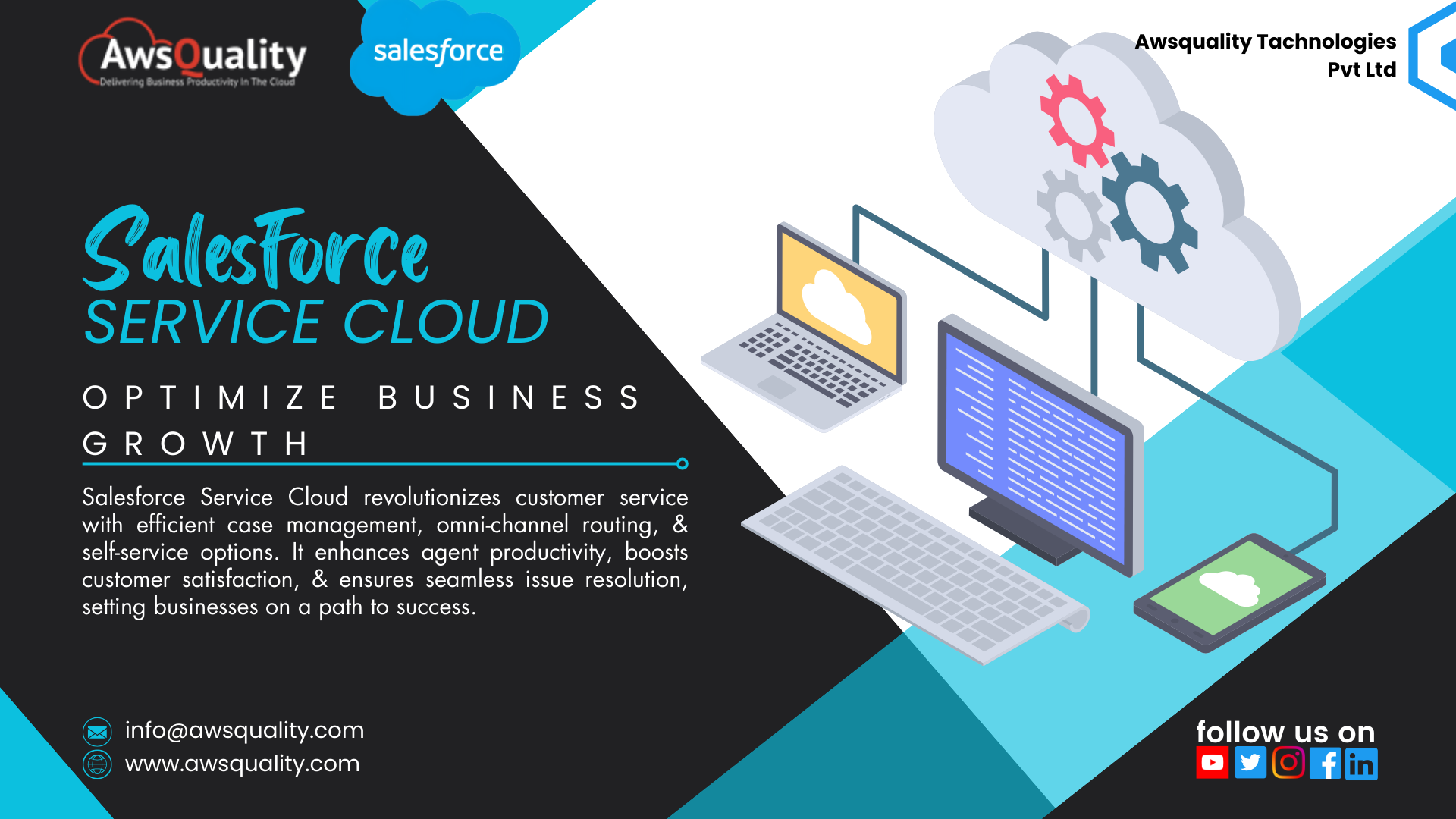
In today’s global business landscape, Salesforce Service Cloud Solution and Sales Cloud stand out as powerful tools for enhancing customer satisfaction and streamlining sales operations. Service Cloud excels in delivering exceptional customer support, efficient issue resolution, and field technician management, while Sales Cloud focuses on lead management, opportunity tracking, and sales performance analytics. Businesses seeking to optimize their customer relations and sales processes can benefit from Salesforce consulting services offered by experts like AwsQuality.
Salesforce Service Cloud Solution: What Is It?
A robust customer relationship management (CRM) platform created especially for providing excellent customer service is Salesforce Service Cloud (Salesforce Cloud Solutions). Among its primary goals are:
Simplifying Customer Support Procedures: Service Cloud guarantees systematic data logging and reporting, streamlines case management, and routes cases effectively.
Automating Actions: Service Cloud minimizes human labour and saves time by automating repetitive processes.
Improving Customer Satisfaction: Improved customer experiences are a result of responsiveness, personalization, and accessibility across devices.
Important attributes and resources:
Case Management: Efficiently record, disseminate, and monitor consumer questions and grievances.
Track the case’s development until it is resolved.
Agent Workspace: Equipping support teams with instant access to essential resources directly from the agent console.
Omni-Channel Routing: Handle questions via chat, email, phone, and social media.
Smoothly transition between channels to provide effective assistance.
Self-service and Knowledge Base: Establish and keep up a strong knowledge base.
Give consumers the tools they need to independently identify solutions using self-service portals.
Live chat and chatbots: Instant help via real-time chat support.
Routine questions are handled by chatbots, saving up agent time.
Field Service Lightning: Use dispatching and scheduling to maximise the efficiency of field technicians.
Community Cloud for Customer Communities: Establish branded communities for customer self-service and teamwork.
Dashboards and reports: Monitor service performance KPIs.
Personalize dashboards and reports.
Advantages of Salesforce Cloud Solution:
Individualized Note: Ad/just assistance to meet the needs of each customer.
First Response Quick: Respond to questions right away.
Device Compatibility: Suitable for a variety of devices.
Integration: Easily interfaces with back-end systems and other Salesforce capabilities.
Recall that Salesforce Service Cloud Solution is revolutionizing customer support. Examine these functions and scenarios to improve customer happiness and service quality!
What distinguishes Salesforce Sales Cloud from Service Cloud?
The main variations between Salesforce Sales Cloud (Salesforce Cloud Solutions) and Service Cloud are as follows:
1. Features Shared:
Since the Salesforce Platform is the foundation for both Service Cloud and Sales Cloud, they have some features in common:
Contacts and Accounts: For both sales and support teams, managing client accounts and important connections inside those accounts is crucial.
Basic Case Management: Sales Cloud offers some basic case management functions, whereas Service Cloud offers more comprehensive case management. This makes it possible for sales teams to see what support difficulties their clients are having and to help them as needed.
2. Sales Cloud:
Target audience: Sales representatives and managers are the intended users of Sales Cloud.
Functionality:
Lead Management: Bringing in and developing potential clients via the sales funnel.
Lead Assignment Rules: Allocating new leads to representatives or groups automatically based on variables like as product interest or geography.
Opportunity Management: Keeping tabs on transactions and overseeing the sales funnel.
Predicting future revenue: Using historical data analysis to anticipate upcoming sales trends.
Quoting and Contract Administration: generating quotes and overseeing agreements.
Analytics for Sales Performance: Tracking the effectiveness of the sales staff.
Objectives: Closing transactions, advancing leads, and gaining new accounts.
3. Cloud Service:
Aim: Designed with service agents and managers in mind.
Performance:
Agent Efficiencies: Instruments to improve agent output.
Customer Experience: Offering top-notch assistance via chat, email, phone, and social media.
Case Management: Managing client complaints under business procedures and service level agreements (SLAs).
Omni-Channel Routing: Allocating work to agents in an efficient manner according to their skill sets and availability.
Knowledge Base and Self-Service: Enabling users to independently locate solutions.
Enhancing field technician efficiency: Field Service Lightning.
Building branded self-service communities with the Community Cloud for Customer Communities.
Objective: Managing service procedures, addressing problems, and guaranteeing client pleasure.
In conclusion,
Support Cloud provides exceptional customer support and effective issue resolution, whereas Sales Cloud simplifies sales operations. Both help businesses expand by improving their grasp of client wants.
Enhance your customer service and sales operations with Salesforce Service Cloud Solution and Sales Cloud. Uncover personalized assistance, efficient lead management, and streamlined processes. Elevate your business with Salesforce consulting services from AwsQuality. Are you prepared to revolutionize your customer experience and propel your business forward?
To obtain further comprehensive details, please visit www.awsquality.com




